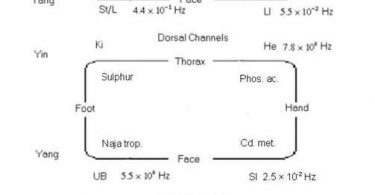Last year, Adelaide, in South Australia, hosted the biennial “Festival of Ideas”. One of the invited guests to this gabfest was Dr Simon Singh, UK science writer, broadcaster and co-author with former Exeter University’s Professor Edzard Ernst of the book, Trick or Treatment? Alternative Medicine on Trial, supposedly an expose of the myths and misconceptions surrounding “alternative medicine”. In an article published in the Adelaide Advertiser (Adelaide’s main daily newspaper) around this time, Dr Singh was quoted as saying, “Homeopathy does not work…”1. This statement went completely unchallenged by the Adelaide Advertiser and no doubt remained so during the “Festival of Ideas”. Previous issues of this journal have carried articles on research related to homeopathy that show quite clearly that Singh’s assertion is untrue. Following are abridged highlights from more homoeopathic research that hopefully helps to add to the mass of data already accumulated in this area to date.
Human Studies
1. Waldschütz R, Klein P. The homeopathic preparation Neurexan Vs. Valerian for the Treatment of Insomnia: An observational study. Scientific World Journal.2008 Apr 20; 8: 411-20. This German study, conducted across 89 clinics, compared the effects of a homeopathic combination preparation to valerian on sleep latency (the time taken to fall asleep), sleep duration, the quality of sleep, and daytime fatigue, over a period of 28 days. 409 people were enrolled in the study and analysis of the results found an improvement from both medicines with a reduction in latency time (37.3 minutes for the combination versus 38.2 minutes for valerian) and increase in sleep duration (2.2 hours for the combination versus 2 hours for valerian). The primary difference between the 2 interventions appeared to be that the homeopathic combination resulted in less daytime fatigue than valerian- 49% versus 32%.
2. Witt CM, Ludtke R, Mengler N, Willich SN. How healthy are Chronically Ill Patients after Eight years of Homeopathic Treatment? – Results from a long term observational study. BMC Public Health 2008, 8:413. German academic and researcher, Professor Claudia Witt, has been responsible for a number of excellent papers on homeopathy and in this, she and co-workers drew data from 103 Swiss and German homeopathic medicine clinics in an effort to determine the level of change to the health status of patients over periods of 2 and 8 years as a result of homeopathic intervention over these times. Data was collected from 3709 patients who were asked to assess the level of change to the severity of their medical complaints and quality of life, at the time of first consultation, at 2 years, and at 8 years from that point. The data from adults and children were assessed separately and the former experienced an average reduction in disease severity from 6.2 at baseline to 2.9 at 2 years to 2.2 at 8 years. For children, a reduction from a baseline disease severity of 6.1 to 2.1 at 2 years was noted and then to 1.7 at 8 years. Physical and mental quality of life scores for both groups increased significantly over the study period and interestingly, researchers found that, within the confines of this study, the younger the patient and the more severe the medical condition, the better the potential for the therapeutic success of homeopathy.
3. Pomposelli R, Piasere V, Andreoni C, Costini G, Tonini E, Spalluzzi A, Observational study of Homeopathic and Conventional therapies in patients with Diabetic Polyneuropathy. Homeopathy. 2009 Jan;98(1):17-25. Researchers at the University of Verona in Italy designed this observational study to compare the effects of homeopathic therapy with conventional drug therapy for diabetic neuropathy. Over a 12 month period, 32 patients treated with homeopathy and 29 patients given conventional drug therapy were assessed for clinical symptoms and quality of life at baseline, 6 months and 12 months after beginning treatment. Improvement from baseline polyneuropathy symptoms was noted in both groups but only those treated homeopathically reached outcomes that were statistically significant. Both groups experienced improvements in blood pressure and body weight as well as levels of fasting blood glucose and glycated haemoglobin. In addition, only those in the homeopathy group noted an improvement in quality of life scores over the period of the study. It was also noted that homeopathic treatment was more economical than the conventional drug alternative.
4. Banerjee A, Chakrabarty SB, Karmakar SR, Chakrabarty A, Biswas SJ, Haque S, Das D, Paul S, Mandal B, Naoual B, Belon P, Khuda-Bukhsh AR. Can Homeopathy bring additional benefits to Thalassemic Patients on Hydroxyurea Therapy? Encouraging Results of a Preliminary Study. Evidence Based Complementary and Alternative Medicine. 2007 Oct 29. [Epub ahead of print]. In this observational study, 38 people suffering from thalassaemia who were taking hydroxyurea, were allowed to continue their use of hydroxyurea but were given one of several homeopathic medicines. The effects of this additional treatment was compared to the outcomes of another 38 people suffering from thalassaemia who used hydroxyurea alone, assessed immediately before and at 3 months after starting the homeopathic treatment. Of a range of haematological and clinical parameters, those people using the combined treatment showed an increase in levels of foetal haemoglobin over those on hydroxyurea alone, along with a reduction in serum ferritin. Where splenomegaly was present, a significant reduction in this was noted in those on the combined therapy and this group also noted an improvement in general health with a longer period allowed between blood transfusions.
5. Kassab S, Cummings M, Berkovitz S, van Haselen R, Fisher P. Homeopathic Medicines for Adverse effects of Cancer Treatments. Cochrane Database Systematic Review. 2009 Apr 15;(2):CD004845. Cochrane Reviews investigate the effects of interventions for prevention, or treatment of illness, or rehabilitation from illness, in a healthcare setting. Most Cochrane Reviews are based on overviews of randomized controlled trials and other forms of evidence that are deemed to be appropriate. This review was conducted to determine what, if any, evidence (in the opinion of the Cochrane reviewers) exists for the treatment by homeopathy of the effects of conventional cancer therapies. A search through numerous databases revealed 8 controlled trials involved in this area of study, 7 of which were placebo controlled and 1 of which was against an active treatment. In total, the trials covered the outcomes for 664 people who’d been variously suffering from the adverse effects of radiotherapy, chemotherapy or breast cancer treatment. Of the 8, 2 trials exhibited beneficial effects from homeopathy. One of these involved a comparison between the effects of a topical corticosteroid and a homeopathic mother tincture of calendula for the prevention of dermatitis from radiotherapy where the calendula proved to be superior to the drug. The other involved the successful use of a homeopathic complex for stomatatitis caused by chemotherapy.
Animal Studies
1. Lingg G, Endler PC, Frass M, Lothaller H. Treatment of Highland Frogs from the Two-legged stage with Homeopathically prepared Thyroxin (10-11 – 10-21). Scientific World Journal. 2008 Apr 20;8:446-50. Researchers working in Austria conducted this study to determine the effects of thyroxine, homeopathically potentised to 11X and 21X, on the metamorphosis rates of highland frogs (Rana temporaria) when compared to controls. The assessment of the effects of these remedies was done on the basis of the number of 2 legged tadpoles that develop into frogs with 4 legs over fixed periods of time. 90 animals in all acted as the subjects in this trial. As would be expected, given that thyroxine would stimulate development, thyroxine 11X and 21X, when compared to controls, were found to suppress the development of tadpoles into frogs over the observation period.
2. Sakakura CE, Neto RS, Bellucci M, Wenzel A, Scaf G, Marcantonio E Jr. Influence of Homeopathic Treatment with Comfrey on Bone Density around Titanium Implants: A Digital Subtraction Radiography Study in Rats. Clinical Oral Implants Research. 2008 Jun;19(6):624-8. This controlled trial looked at populations of rats to discover what influence, if any, Symphytum 6C had on improving the density of bone around recent titanium implants. Implants were given to 2 groups of 24 rats; one group was given 10 drops of Symphytum 6C per day and the other was given a similar amount of a control substance. Animals were radiologically assessed for bone density around the implants at the beginning of the study period, and again at 7, 14 and 28 days. Radiographs taken at day 7 showed an increase in bone density over controls, although no statistically significant effect was seen for the radiographs taken on days 14 and 28.
3. Bhattacharjee N, Pathak S, Khuda-Bukhsh AR. Amelioration of Carcinogen-Induced Toxicity in Mice by Administration of a Potentized Homeopathic Drug, Natrum Sulphuricum 200. Evidence Based Complementary and Alternative Medicine. 2007 Jun 19. [Epub ahead of print]. In this study, which used 2 separate controls, researchers at the Department of Zoology at the University of Kalyani in India used mice to determine whether or not Natrum sulphuricum in the 200th potency had any impact on the carcinogenic effects of P-dimethylaminobenzene and the cancer-promoting effects of Phenobarbital. The study was carried out over 120 days and at the end of this period, when compared to controls, it was found that Natrum sulph 200C reduced the level of damage caused to genes by carcinogens, corrected the levels of acid phosphatase, alkaline phosphatase, aspartate amino transferase, alanine amino transferase, reduced lipid peroxidation and produced an increase in glutathione levels.
Plant Studies
1. Scherr C, Simon M, Spranger J, Baumgartner S. Effects of Potentised Substances on Growth Rate of the water plant Lemna gibba. Complementary Therapies in Medicine. 2009 Apr;17(2):63-70. Claudia Scherr and colleagues at the Research Institute of Organic Agriculture in Frick, Switzerland, conducted this randomised, controlled and blinded study to determine the extent to which various potentised substances could influence the growth of Duckweed (Lemna gibba) when compared to controls. To do this, Duckweed was grown in 14X to 30X homeopathic potencies of Argentum nitricum, Lemna minor and Gibberelic acid (a known plant growth regulator) over a period of 7 days. Measurements were taken over 0-3 days, 3-7 days and 0-7 days. Succussed and un-succussed water was used as controls. Neither controls produced any statistically significant effect and the potencies that caused the most pronounced reduction in growth when compared to controls were those of Gibberelic acid, particularly the 15X, 17X, 23X and 24X potencies.
In Vitro Studies
1. Sunila ES, Kuttan R, Preethi KC, Kuttan G. Dynamized Preparations in Cell Culture. Evidence Based Complementary and Alternative Medicine. 2007 Oct 3. [Epub ahead of print]. This paper presents the results of studies carried out by researchers at the Amala Cancer Research Centre in Kerala, India, on the cytotoxic (cell killing) effects of a range of homeopathic mother tinctures and potencies on various types of cancer cells grown in tissue culture. When compared to controls, potentised Thuja, Hydrastis and Carcinosin were found to have cytotoxic capacities or were able to accelerate cell death.
2. Witt CM, Bluth M, Albrecht H, Weisshuhn TE, Baumgartner S, Willich SN. The In-Vitro Evidence for an Effect of High Homeopathic Potencies–a Systematic Review of the Literature. Complementary Therapies in Medicine. 2007 Jun;15(2):128-38. This was essentially a meta-analysis of all of the in-vitro studies that have attempted to demonstrate a homeopathic effect to date, carried out by Professor Claudia Witt and colleagues at the Department of Epidemiology and Health Economics, Charité University Medical Center in Berlin, Germany. The aim here was to search all appropriate databases for relevant studies, determine which studies met the quality criteria set by the researchers, and then to determine which, if any of these, exhibited a statistically significant effect in this area. 67 papers were identified that met the quality criteria and of these, 73% found that an effect from high potencies can be demonstrated. The majority of these studies involved the effects of potentised substances on basophils. Replication of some of these studies has been carried out.
Editor’s note: Robert Medhurst is the author of the recently released : The Concordant Clinical Homeopathic Repertory





Has anyone delt with Glioblastoma Multiforme stage 4 ,after Radiation & chemo failing to stall its growth.